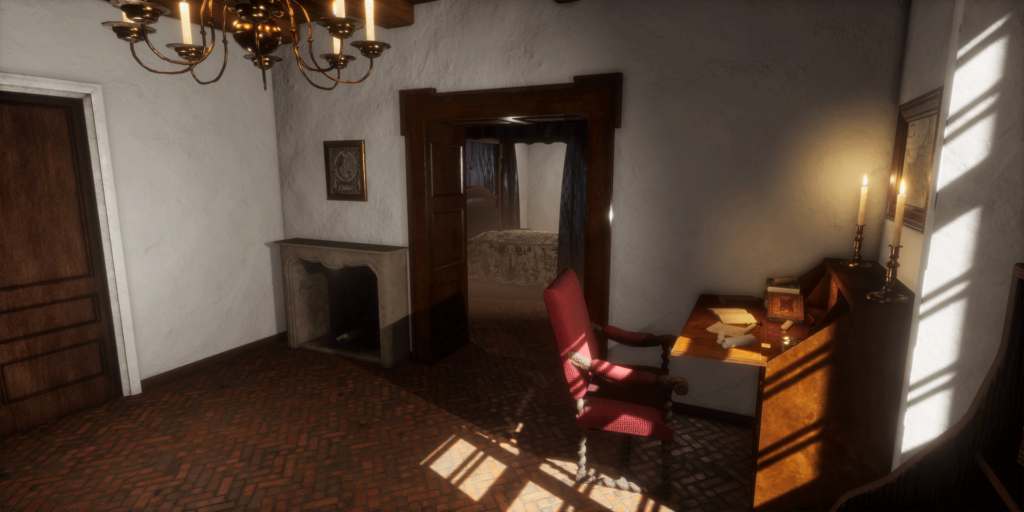Enhancing Heritage
Tidvis AS and Museum Collaborate on “Silent Majority” Project at Bishop’s Castle, Lidzbark Warmiński
Tidvis AS and the Museum proudly present the “Silent Majority” project, a collaborative endeavor dedicated to showcasing the service history of the Bishop’s Castle in Lidzbark Warmiński. Through interactive gaming, detailed reconstruction models, multimedia exhibitions, educational workshops, guided tours, and digital archives, visitors can engage with the lives and contributions of the castle’s service staff. The project emphasizes inclusivity, offering experiences in multiple languages and ensuring accessibility for all visitors. Join us in exploring and celebrating the rich heritage of the Bishop’s Castle through this innovative and educational initiative.

A Day in the Palace
A Day in the Palace is a historical visual novel where the player’s choices drive the story. You play as Peter and Marysia, newly arrived siblings at the palace in Lidzbark Warminski in 1772. Here you must learn to navigate the court, perform servant duties, and finally solve a mystery regarding a missing silver spoon. Talk to the servants of the palace to get hints that let you catch the culprit. The game’s backdrop and story are based on historical sources.
There are two different modes of play. The novel mode is a longer visual novel combined with interactive minigames. The minigames include polishing pewter, lighting a fireplace with flint and steel, and making hot chocolate in 1700s fashion. The minigame mode features a shorter story with more emphasis on the minigames and is suitable for a younger audience.
History of the palace
The castle in Lidzbark Warmiński was built in the 14th century as the residence of Warmian bishops. The construction of the castle began with the erection of the perimeter walls, which were systematically expanded in the following years. When the main part of the castle, the so-called proper castle, was erected, a space was created between it and the walls, now called the inter-wall or parcham. Until the 16th century, the inter-wall of the Lidzbark castle remained undeveloped.
3D visualization
To explore the 3D visualization of the castle click on the button below to start the tour.






Silent majority
Service at the bishop’s castle in Lidzbark Warmiński
Noble and ecclesiastical manors were important centers of socio-cultural life in the 18th century. Service at the manor not only provided employment and livelihood but also carried a prestigious character. For boys from poorer gentry backgrounds, it offered opportunities for education and advancement, while for girls, it offered favorable prospects for marriage. Servants at the manor were expected to be honest, maintain order, perform their duties neatly and accurately, and adhere to etiquette. The bishop’s court was predominantly male, with women usually employed as the lowest-ranking servants.
The organization of the manor followed strict structure and hierarchy. Over the centuries, the titles and tasks of the servants changed, following the trends of the time. The only known document dating back to the second half of the 15th century, specifying regulatory provisions at the castle in Lidzbark Warmiński, was titled “Ordinatio Castri.”
During the time of Bishop Marcin Kromer (16th century), the number of servants was quite high, around 120 people. The courts of Bishops Szymon Rudnicki and Andrzej Batory (17th century) comprised just over 70 people. Over time, mainly due to frequent wars and destruction, the number of servants decreased, and by the 18th century, Jan Wydżga had 54, and Ignacy Krasicki had 77 courtiers.





For Teachers
Duis aute irure dolor in reprehenderit in voluptate velit esse cillum dolore eu fugiat nulla pariatur. Excepteur sint occaecat cupidatat non proident, sunt in culpa qui officia deserunt mollit anim id est laborum. Excepteur sint occaecat cupidatat non proident, sunt in culpa qui officia deserunt mollit anim id est laborum.
Workshop info
Duis aute irure dolor in reprehenderit in voluptate velit esse cillum dolore eu fugiat nulla pariatur. Excepteur sint occaecat cupidatat non proident, sunt in culpa qui officia deserunt mollit anim id est laborum. Excepteur sint occaecat cupidatat non proident, sunt in culpa qui officia deserunt mollit anim id est laborum.
Contact information:
Need info










